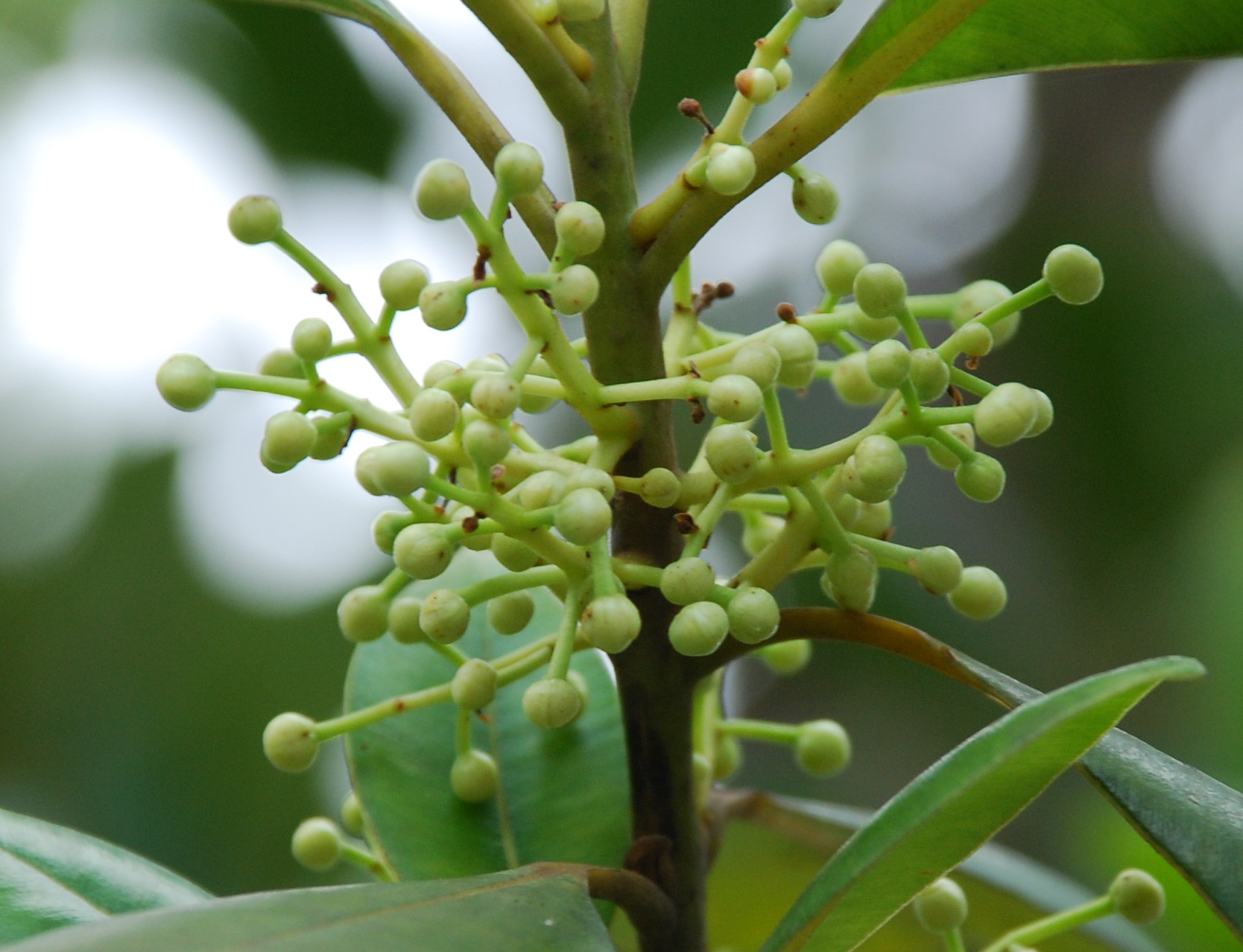- Calophyllum brasiliense
Taxobox
name = "Calophyllum brasiliense"

image_width = 240px
image_caption = Flowers
regnum =Plant ae
divisio = Magnoliophyta
classis = Magnoliopsida
ordo =Malpighiales
familia =Clusiaceae
subfamilia =Kielmeyeroideae
tribus =Calophylleae
genus = "Calophyllum "
species = "C. brasiliense"
binomial = "Calophyllum brasiliense"
binomial_authority = Cambess."Calophyllum brasiliense" (Guanandi) is a species of "
Calophyllum " native to subtropical and tropical regions ofCentral America ,South America andCaribe .Germplasm Resources Information Network: [http://www.ars-grin.gov/cgi-bin/npgs/html/taxon.pl?311269 "Calophyllum brasiliense"] ]It is an
evergreen tree growing to 20–50 m tall, with a trunk up to 1.8 m diameter, and a dense, rounded crown. The leaves are opposite, 6.3–12.5 cm long and 3.2–6.3 cm broad, elliptic to oblong or obovate, leathery, hairless, glossy green above, paler below, with an entire margin. Theflower s are 10–13 mm diameter, with four white sepals (two larger, and two smaller), and one to four white petals smaller than the sepals; the flowers are grouped inpanicle s 2.5–9 cm long. Thefruit is a globulardrupe 25–30 mm diameter.AgroForestry Tree Database: [http://www.worldagroforestrycentre.org/sea/Products/AFDbases/AF/asp/SpeciesInfo.asp?SpID=1737 "Calophyllum brasiliense"] ] Flores, E. M. "Flora of Costa Rica": [http://www.rngr.net/Publications/ttsm/Folder.2003-07-11.4726/PDF.2003-11-13.2538/file "Calophyllum brasiliense" (pdf file)] ]It is very common in
Brazil , from Santa Catarina to Pará, and also inPantanal andAmazon forest; also common inParaguay ,Peru ,Bolivia ,Colombia ,Venezuela ,Mexico ,Belize ,Guatemala ,Nicaragua ,Costa Rica ,Panama ,Puerto Rico ,Trinidad ,Dominican Republic ,Cuba . It occurs between sea level and 1200 meters, many times in pure stands (this capacity in uncommon in tropical hardwood trees). Its natural dispersion occurs by water and fishes, monkeys and mainly by bats.Cultivation and uses
The substitution of irregular, illegal cutting of Amazon trees by using forested trees as Guanandi is proven to be very positive to preserve this important biomes; To cut and transport a single Mahogany, in the Amazon, 30 other trees are destroyed, because Mahogany does not occur in pure stands, as Guanandi does; This substitution is possible because Europeans, Japanese and Americans conscientious buyers are beginning to understand the problem of conserve Amazon forest; so they need to accept paying more for reforested wood; Moreover, the radicular system of trees as Guanandi raises the freatic sheet; it recoups and fertilizes the ground where he is planted. The wood of Guanandi and other speed growth quality timber trees promises to be very important commodities.
Other important trees specimens, in opposite from Guanandi , can not be harvested because they are attacked by Hypsipyla Grandella, Zeller. This "
caterpillar " destroys the main structure of this trees: Genuine South American Mahogany (Swetenia macrophila), Brazilian Cedar (Cedrela fissilis) and Crabwood (Carapa Guianensis)Guanandi word comes from the Tupy (a Brazilian Indian folk) language, means "soap that glues", in function of the yellow latex (balsam) of the rind, known as Jacareubin; It has the following medicinal uses: Against ulcer and gastritis; To avoid prostate damages. For skin cicatrization; against solar burning. In combat to molluscs that transmit "doença de Chagas" parasite. Some American and Asian universities also study the effect in reduction of cancer tumors. In addition, Terracom labs in a joint venture to Sarawak Medichen in Indonesia are providing patent for the use of
Calanolide A and Calanolide B, present in the latex and in the leaves of Calophyllum as AIDS inhibitors.It is used in the cosmetic and dermatological industry, the oil being known as tamanu oil, for skin cleaning, and against skin wrinkles, after tattoo skin care. The fruit is composed of 44% of oil, and it can be burnt as bio-fuel. There are dozens of references about calophyllum oil active properties, from pre Colombian Incas and Aztecs in Latin America, to Asian and Polynesian Islands.
Common trade names of the wood of the "Calophyllum brasiliense" are: Jacareúba, Guanandi and Árbol de Santa Maria. Also known as: Landim, Olandim, Landi, Cedro do Pântano, Guanandi-Cedro(Brazil), Arary, Ocure, Cachicamo, Balsamaria, Aceite Mario, Palomaria or Pallomaria, Brazil beauty leaf (Brazilian pretty leaf) and even of Alexander Laurel, or crown of parrots of Alexander, for the beauty of its leaves.
In São Paulo state, southeastern Brazil, some cities have
plantation s of Guanandi, with about one million trees planted. The same occur in UNA, south of Bahia state, where some guanandi tree farms have already started theirs production.References
External links
* [http://www.ipef.br/identificacao/nativas/detalhes.asp?codigo=56 "Calophyllum brasiliensis" (Instituto de Pesquisas e Estudos Florestais)]
*http://www.terracompr.com/Projects/advancedlife.html] .
*http://www.aegis.com/news/PR/1998/PR980218.html
*http://www.aidsmap.com/cms1032372.asp
*http://www.drugs.com/npc/calanolide-a.html
*http://ci.nii.ac.jp/naid/110003609000/en/
Wikimedia Foundation. 2010.
